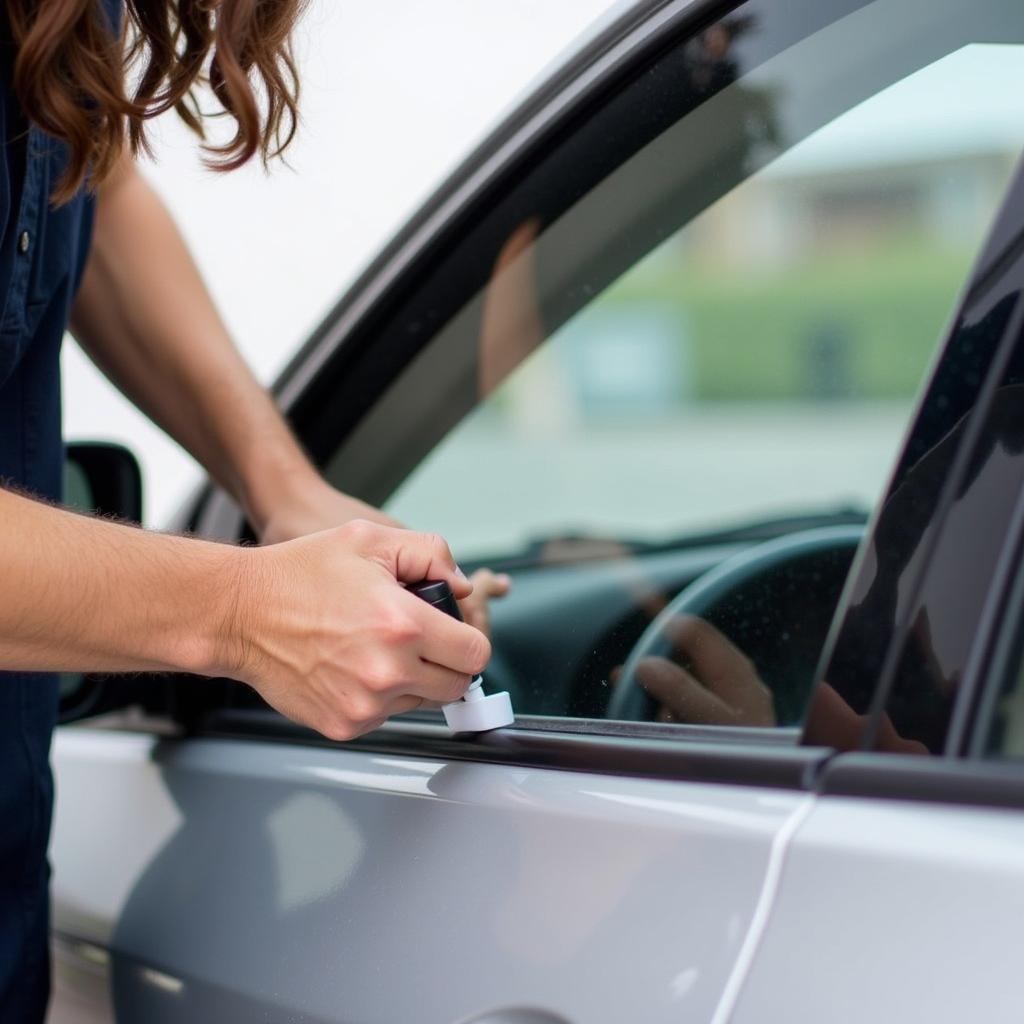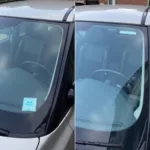Car window sealant repair is crucial for maintaining a safe and comfortable driving experience. A damaged seal can lead to water leaks, wind noise, and even structural problems. This guide provides everything you need to know about car window sealant repair, from identifying the problem to choosing the right repair method. Learn how to prevent future damage and keep your car in top condition.
Understanding the importance of a properly sealed car window is the first step to addressing any issues. A good seal not only keeps the elements out but also plays a vital role in the structural integrity of your car. Compromised seals can lead to a variety of problems, ranging from minor annoyances to significant safety hazards. You can find more detailed information on specific car window molding repairs here: car side window molding repair.
Signs Your Car Window Seal Needs Repair
Several signs indicate a failing window seal. These include:
- Water leaks: Notice water accumulating on the floor mats or inside the door panels after rain? This is a strong indicator of a leaky window seal.
- Wind noise: Excessive wind noise at higher speeds can point to a compromised seal that’s allowing air to enter the cabin.
- Visible damage: Cracks, tears, or gaps in the sealant are obvious signs of damage and require immediate attention.
- Musty odor: A persistent musty smell inside your car, especially after rain, can indicate water trapped due to a faulty seal, leading to mold and mildew growth.
DIY vs. Professional Car Window Sealant Repair
Deciding whether to tackle car window sealant repair yourself or hire a professional depends on your skills and the extent of the damage. Minor cracks or gaps might be manageable with DIY repair kits. However, more extensive damage often requires professional expertise for a lasting solution. You can learn more about DIY molding repair here: how to repair car window molding.
DIY Car Window Seal Repair
DIY repair kits are readily available and usually contain sealant, applicator tools, and cleaning solutions. For small repairs, this can be a cost-effective option. However, it’s essential to follow the instructions carefully and ensure the area is thoroughly cleaned and prepped for optimal adhesion.
Professional Car Window Seal Repair
For significant damage or if you’re uncomfortable with DIY repairs, seeking professional help is recommended. Professionals have the experience and tools to assess the damage accurately and perform a lasting repair. They can also identify any underlying issues that might be contributing to the seal failure. For those in Salt Lake City, check out: car window sealant repair salt lake.
Preventing Car Window Seal Damage
Proactive measures can help extend the life of your car window seals and prevent premature failure:
- Regular cleaning: Clean the seals with a mild soap and water solution to remove dirt and debris that can cause wear and tear.
- Avoid using harsh chemicals: Harsh chemicals can damage the rubber seals, making them brittle and prone to cracking.
- Park in the shade: Prolonged exposure to direct sunlight can dry out and degrade the rubber seals over time.
- Inspect the seals regularly: Catching damage early can prevent it from escalating and requiring more extensive repairs. Check out more on rubber seal repair: car window rubber seal repair.
 Applying Car Window Sealant Correctly
Applying Car Window Sealant Correctly
“Preventing seal damage is often more cost-effective than dealing with repairs,” advises John Smith, Senior Automotive Technician at Expert Auto Solutions. “Regular inspections and simple cleaning can significantly extend the lifespan of your window seals.”
Choosing the Right Car Window Sealant
Selecting the appropriate sealant is crucial for a successful repair. Different types of sealants are available, including:
- Butyl tape: A popular choice for its excellent adhesion and durability.
- Polyurethane sealant: Offers good flexibility and weather resistance.
- Silicone sealant: Provides a strong bond and is resistant to temperature fluctuations.
“Using the correct sealant is essential for a long-lasting repair,” says Maria Garcia, Lead Mechanic at Precision Auto Care. “Consult your car’s manual or a professional to determine the best type of sealant for your specific vehicle.”
Car Window Sealant Repair: Conclusion
Car window sealant repair is a vital aspect of car maintenance. Addressing damaged seals promptly can prevent further problems and ensure a safe and comfortable driving experience. Whether you choose a DIY approach or seek professional help, understanding the different aspects of car window sealant repair empowers you to make informed decisions. For those concerned about costs, check out this resource: [broken car window seal repair cost](https://carrepairon.com/broken-car window-seal-repair-cost/). Remember, regular maintenance and preventative measures can help prolong the life of your seals and keep your car in optimal condition.
FAQ
- How often should I inspect my car window seals?
- Can I use any type of sealant for car window repair?
- How long does it take for car window sealant to dry?
- What are the signs of a poorly installed car window seal?
- How much does professional car window sealant repair cost?
- Can I drive my car immediately after a car window sealant repair?
- What should I do if my car window seal continues to leak after repair?
Common Car Window Seal Repair Scenarios:
- Water leak around the window during rain: This typically indicates a damaged or deteriorated seal.
- Excessive wind noise at highway speeds: A sign of a failing seal or improper installation.
- Mold or mildew growth around the window frame: Suggests a long-standing leak and trapped moisture.
Related Articles and Resources:
- How to Replace a Car Window
- Understanding Different Types of Car Window Sealants
- DIY Car Maintenance Tips
If you need any assistance or have questions, please don’t hesitate to contact us via WhatsApp: +1(641)206-8880, or Email: [email protected]. Our customer service team is available 24/7.

